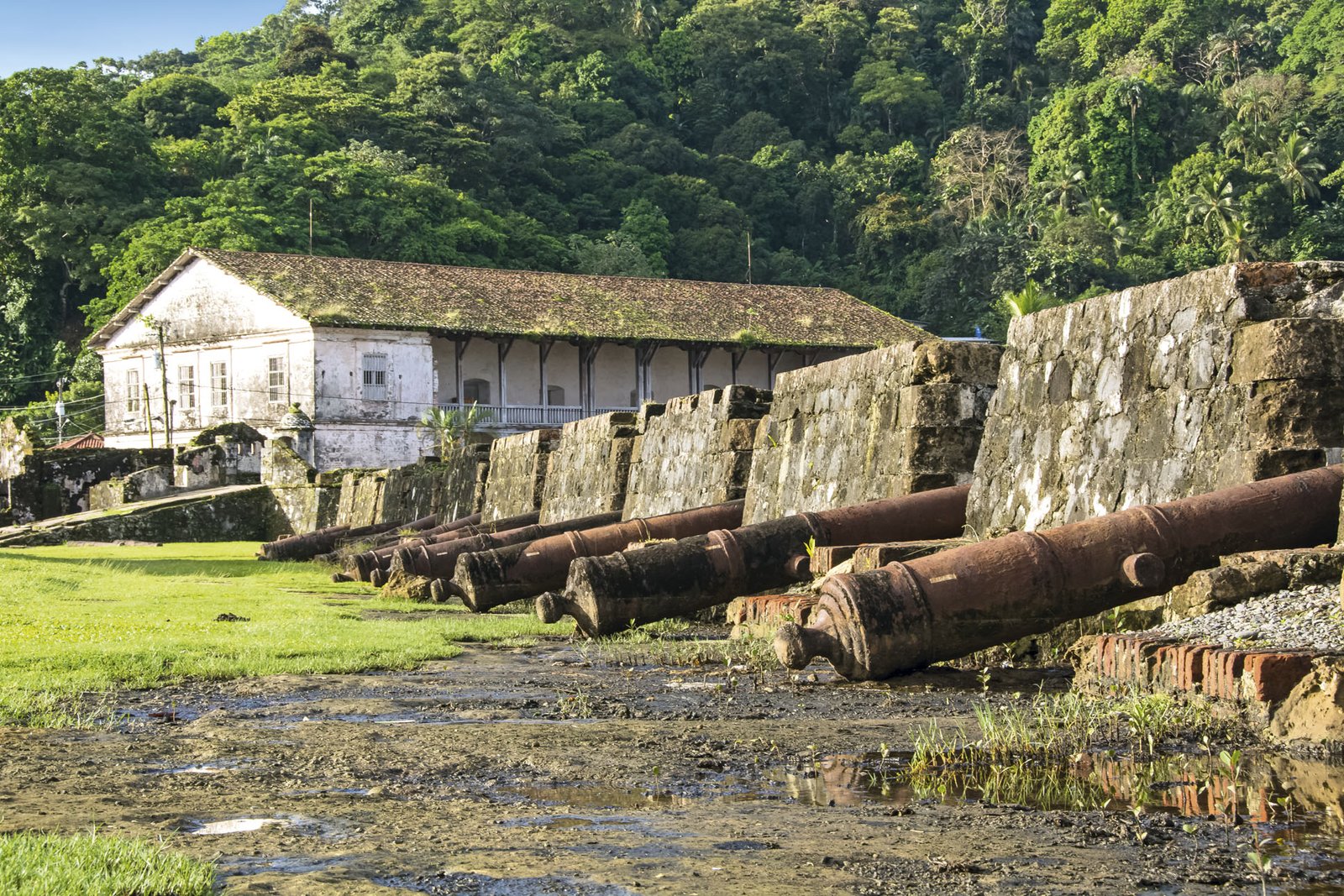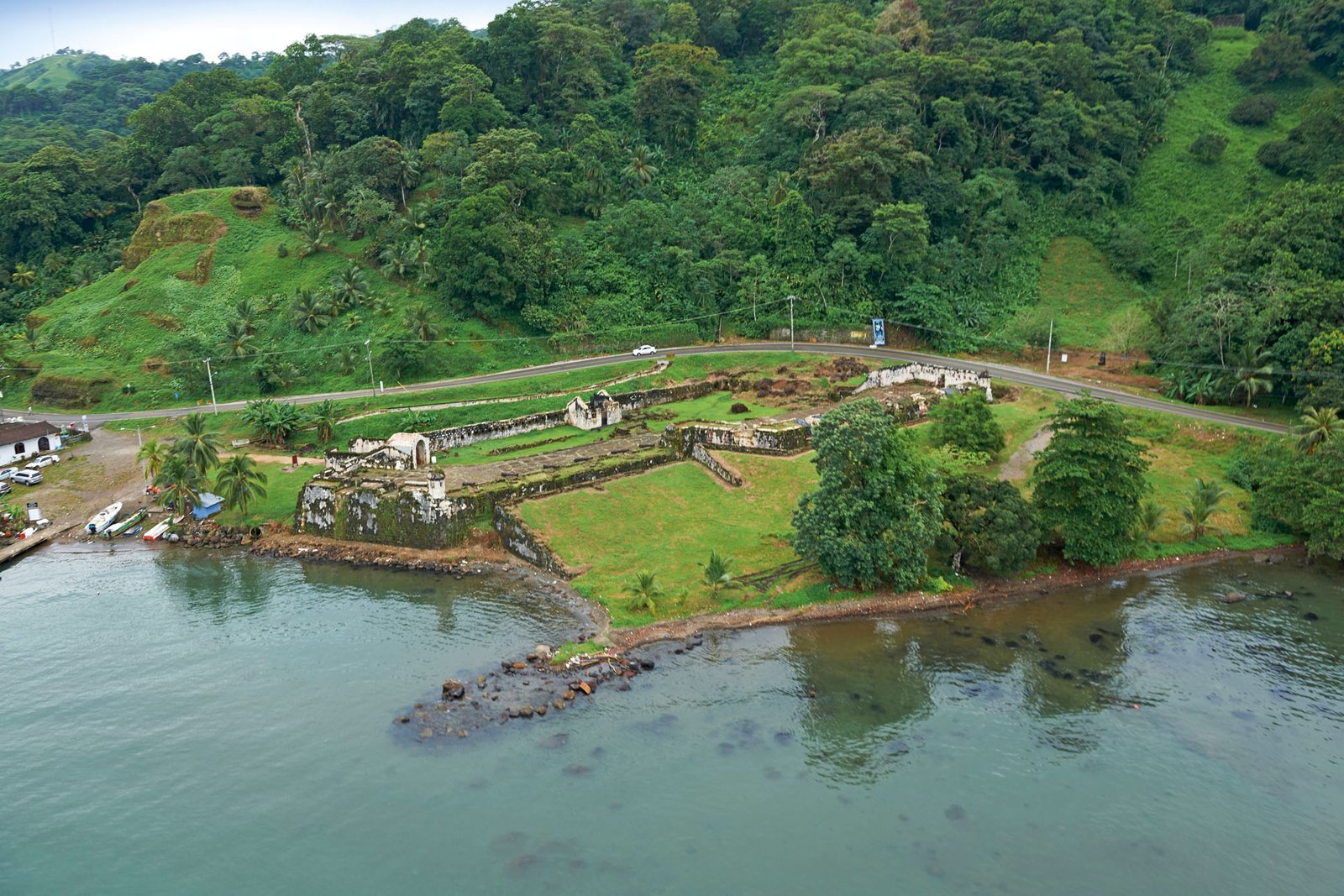
Defending Portobelo
By Panorama of the Americas Editorial Staff
Photos: Carlos Gómez
From my perch on a 17th century cannon at the top of a hill, I gaze down on lovely Portobelo Bay. From here I can imagine the turbulent past that muddied the mirrored surface of these now tranquil waters. It was the year 1606, and the commercial heart of Spain, the greatest power in the world, beat in this now-anonymous town on the Panamanian Caribbean. Other European powers were eager to wrest from Spain not only the treasures of the Inca Empire, but the very reason for Spain’s domination: control of the narrow strip of land that linked the Atlantic to the recently discovered Southern Sea, and with it, access to the rest of the Americas.
The enormous volume of trade between the Iberian Peninsula and the West Indies culminated in the Portobelo Fairs, where Spanish merchants brought European products to Portobelo to sell, and loaded ships with riches amassed in the Americas for the return journey. The fairs were held from 1544 to 1597 in Nombre de Dios, but were moved to Portobelo in 1606, since a much larger number of ships could anchor in its bay, and the bay’s shape made it easier to defend.

I can imagine scurrying, sweating officials weighing gold and silver at the Customs House. There would have been the public market, where terrified and powerless slaves were exhibited like merchandise while wholesalers bargained for the best price. Royal officials monitored the volume and value of the merchandise and recorded the exchanges to prevent fraud.
While this was going on under the blazing tropical sun, pirates, buccaneers, and corsairs from England, Holland, and France, plied the seas offshore, coveting those riches and preparing attacks, sometimes on their own behalf and sometimes on behalf of their countries. Today, the expanse of serene waters spreads over dozens of sunken ships that represent this turbulent past.
It is not surprising that the Spaniards called on their best engineers to build fortifications to protect the city. Until 1739, when the fairs began to languish, Portobelo suffered savage attacks and the forts were destroyed, rebuilt, and modified dozens of times.
Fortifications have been discovered in the waters around the entire Portobelo shoreline: Fort Santiago de la Gloria, the lower (San Fernando) and upper (San Fernandino) batteries, Fortress San Felipe de Todofierro, Fort San Jerónimo, Fort Farnesio, and the Buenaventura defenses. Some of these fortifications have endured almost in their entirety, while others have been reduced to bits of stone, but they all testify to an era in which Portobelo was the trade capital of the world.
Fort San Fernando

The fort comprises three structures. The lower battery was built by Ignacio Sala in 1760, along with the reconstruction of Fort Santiago de la Gloria. The two structures functioned together, aiming their cannons at the mouth of the bay. The top of the adjacent hill is the site of the upper battery of San Fernandino, equipped with several cannons and gunpowder storage; the hill is high enough to permit ships to be sighted. It also has an oven for heating gunpowder or cooking, and a well from which to draw water. Continuing up the path behind the upper battery, visitors will come across Casa-Mata or Fort-House, which is surrounded by a trench and also acted as a storage site for gunpowder and water.
Fort Santiago de la Gloria
One of the first two forts in Portobelo, originally known as Fortress Santiago, the fort dates to the early 17th century and was designed by architect Bautista Antonelli. The original structure is called “El Peñón” (The Rock), because the surviving ruins resemble an enormous rock, which has now been commandeered by weeds. After an attack by English admiral Edward Vernon in 1739, the city’s defenses were reconfigured; they were moved and rebuilt in 1753 and named Fort Santiago de la Gloria. Both configurations of the fort were designed to serve as gatekeepers to allow merchandise in while keeping pirates out. The second embodiment featured two rows of cannons, a huge gunpowder store, and several sets of barracks.
Fort San Jerónimo

This fort stands near the celebrated Portobelo Customs House. In 1601, when corsair William Parker easily breached the defenses of widely separated San Felipe and Santiago de la Gloria and captured the town, the need for another fort on the Portobelo coast became evident. This was the genesis of San Jerónimo, erected first on an islet off the coast, then in 1620 on land fill as a bastion by architect Cristóbal de Roda, and finally, as a fort, built between 1658 and 1663. In 1753, the Spanish Crown sent military engineer Ignacio Sala to Portobelo to refashion the defenses. Fort San Jerónimo was supplemented by an embankment that connected it to the mainland and provided an emplacement for walls with cannons that pointed toward the bay, giving the fort the appearance we are familiar with today.
Fort Farnesio
Along with large forts, other smaller defensive structures were constructed to complement the bay’s fortifications. Fort Farnesio is located near Santiago de la Gloria, just outside the entrance to Portobelo. Built in 1726, Farnesio was intended as a temporary structure that would eventually make way for a larger fortress that should have begun to rise in 1731, but was never actually constructed. It had just three cannons and served to support the firepower of San Fernando and San Felipe de Todofierro, located across from it on the other side of the bay.
The Buenaventura Defenses
Found up a hill in the patio of a private residence, the defenses were located behind Farnesio and performed the same complementary defensive function. On historical maps drawn by Agustín Crame and Juan de Herrera in the 18th century, Buenaventura is shown as part of the Portobelo fortifications. The three defensive cannons were placed to make good use of the mountain slope, reinforcing protection for Portobelo, which had recently been plundered by Edward Vernon. The ruins we see today consist of only a wall, partially camouflaged by weeds and degraded by erosion and time.

Fortress San Felipe de Todofierro
This was one of the forts planned by Bautista Antonelli when Portobelo was founded in 1597. Located on the northern point of Portobelo Bay, it protected the entrance, along with the original Santiago de la Gloria. Todofierro is noticeably medieval in appearance as it is one of the oldest of Portobelo’s defenses. Its distant location proved the undoing of Fortress San Felipe, since it was rendered useless during attacks as soon as pirates entered the bay. In 1739 the Fortress was captured and dismantled by Admiral Edward Vernon. Engineers Ignacio Sala and Manuel Hernández used the remains to build the upper and lower batteries of San Fernando.



